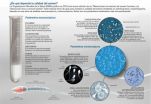(Press-News.org) The first comparative study on the evolution of sperm quality in young Spanish men over ten years, headed by researchers at the University of Murcia, reveals that spermatozoid concentration in men between 18 and 23 years in the regions of Murcia and Almeria has dropped by an annual average of 2%.
The suspicion that the semen of Spanish men is losing quality now takes force in the case of young men from Murcia and Almeria.
The 'Andrology' journal has published a multidisciplinary and international study, headed by the Department of Preventative Medicine and Public Health of the University of Murcia (UMU), which demonstrates that "total sperm count and concentration has declined amongst young men in the south-east of Spain in the last decade." More specifically, the decrease amounts to 38%.
The lead researcher, Alberto Torres Cantero, explains to SINC that the study involved "comparing the results obtained by the Medical Research Centre of the University of Granada from the semen of 273 men from Almeria between 18 and 23 years, collected between 2001 and 2002, with those samples collected ten years later by 215 undergraduates from Murcia, all the while ensuring that both sample groups had the same age range and similar characteristics."
The analysis shows that the number of spermatozoids is significantly lower in the subjects from Murcia compared to the participants from Almeria. Average concentration goes from 72 million spermatozoids per millilitre in 2011 to 52 million/ml in 2011, according to Torres Cantero, professor of Preventative Medicine and Public Health at UMU.
Another relevant result is that "40% of those university students analysed in Murcia suffered from alterations in at least one semen parameter (morphology, mobility). Furthermore, all sperm indicators are below the norm in 15% of the sample," states Jaime Mendiola, professor at the UMU and first signatory of the study.
Clinic trails are needed
"Before there were no well performed studies to detect a change in sperm quality in Spain," explains Torres. Its main limitation is that it only makes reference to one geographic area and cannot be extrapolated: "We do not know if the same has occurred in other parts of Spain," outlines the researcher. There is little likelihood that the study will be carried out in other regions "because there are no similar semen quality studies in the young and healthy population."
Nonetheless, the fact that semen has worsened does not necessarily mean that the number of infertile men has increased. As Torres clarifies, this study measures semen quality and not fertility, "for which specific criteria established by the WHO are used."
Despite this, Mendiola feels that these data are worrying because "it has been verified in recognised studies that a concentration lower than 40 million/ml makes conception more difficult. If the rate of loss we have outlines continues, with an average decline in quality of 2% per year, the sperm of young men could reach this danger level of 40 million/ml in a very short space of time."
For this reason, the authors stress the urgency to promote "clinical trails that identify effective prevention actions for counteracting this negative trend via lifestyle changes."
"We believe that some prevention actions involving lifestyle improvements, such as a healthier diet, could increase sperm quality," outlines Alberto Torres. "But we still lack rigorous scientific information to propose them neither in the clinical field nor at a population level. If we could identify those actions, we could improve sperm quality."
INFORMATION:
This study enjoyed the participation of the Department of Preventative Medicine of New York's Mount Sinai Hospital, the Reproduction Department of the University of Copenhagen, the Spanish universities of Granada and Miguel Hernández (Elche) and Dexeus and Fertilidad Roca clinics in Murcia. It was financed by the Fundación Séneca - the Science and Technology Agency of the Region of Murcia - and the Health Research Fund (FIS) of the Carlos III Institute.
Contact:
Alberto Torres Cantero
investigador principal
catedrático de Medicina Preventiva y Salud Pública de la Universidad de Murcia
amtorres@um.es
teléfono: 868 88 46 57
Reference:
http://onlinelibrary.wiley.com/doi/10.1111/j.2047-2927.2012.00058.x/abstract;jsessionid=F1B8DE0AD83F78A0DFAC4F2BF4ADF7C2.d04t04
Semen quality of young men in south-east Spain down by 38 percent in the last decade
2013-01-18
ELSE PRESS RELEASES FROM THIS DATE:
Unrestricted access to the details of deadly eruptions
2013-01-18
Volcanic eruptions have the potential to cause loss of life, disrupt air traffic, impact climate, and significantly alter the surrounding landscape. Knowledge of the past behaviours of volcanoes is key to producing risk assessments of the hazards of modern explosive events.
The open access database of Large Magnitude Explosive Eruptions (LaMEVE) will provide this crucial information to researchers, civil authorities and the general public alike.
Compiled by an international team headed by Dr Sian Crosweller from the Bristol's School of Earth Sciences with support from ...
Breakthrough for solar cell research
2013-01-18
In the latest issue of Science, researchers from Lund University in Sweden have shown how nanowires could pave the way for more efficient and cheaper solar cells.
"Our findings are the first to show that it really is possible to use nanowires to manufacture solar cells", says Magnus Borgström, a researcher in semiconductor physics and the principal author.
Research on solar cell nanowires is on the rise globally. Until now the unattained dream figure was ten per cent efficiency – but now Dr Borgström and his colleagues are able to report an efficiency of 13.8 per cent. ...
Climate change to profoundly affect the Midwest in coming decades
2013-01-18
ANN ARBOR—In the coming decades, climate change will lead to more frequent and more intense Midwest heat waves while degrading air and water quality and threatening public health. Intense rainstorms and floods will become more common, and existing risks to the Great Lakes will be exacerbated.
Those are some of the conclusions contained in the Midwest chapter of a draft report released last week by the federal government that assesses the key impacts of climate change on every region in the country and analyzes its likely effects on human health, water, energy, transportation, ...
ARS scientists test improved stink bug trapping methods
2013-01-18
This press release is available in Spanish.
Baited black traps in a pyramid shape attract significantly more brown marmorated stink bugs than other traps, according to U.S. Department of Agriculture (USDA) scientists. Evaluating stink bug responses to different visual stimuli may help manufacturers design better traps for monitoring the bugs.
Entomologist Tracy Leskey at the Agricultural Research Service (ARS) Appalachian Fruit Research Station in Kearneysville, W.V., focused on visual stimuli that can attract the stink bugs to traps that will help farmers monitor ...
Studying ancient Earth's geochemistry
2013-01-18
Washington, D.C.— Researchers still have much to learn about the volcanism that shaped our planet's early history. New evidence from a team led by Carnegie's Frances Jenner demonstrates that some of the tectonic processes driving volcanic activity, such as those taking place today, were occurring as early as 3.8 billion years ago. Their work is published in Geology.
Upwelling and melting of the Earth's mantle at mid-ocean ridges, as well as the eruption of new magmas on the seafloor, drive the continual production of the oceanic crust. As the oceanic crust moves away ...
Wild animals may contribute to the resurgence of African sleeping sickness
2013-01-18
Wild animals may be a key contributor to the continuing spread of African sleeping sickness, new research published in PLOS Computational Biology shows. The West African form of the disease, also known as Gambiense Human African trypanosomiasis, affects around 10,000 people in Africa every year and is deadly if left untreated.
The disease is caused by a brain-invading parasite transmitted by bites of the tsetse fly, and gets its name from the hallmark symptoms of drowsiness and altered sleeping patterns that affect late-stage patients, along with other physical and neurological ...
Factors linked with survival differences between Black, White kidney failure patients
2013-01-18
Highlights
Residence in areas with higher average household income was linked with improved survival in kidney failure patients.
In White patients, income inequality was associated with mortality.
In Black patients exclusively, residence in highly segregated areas was associated with increased mortality.
More than 590,000 Americans in 2010 were treated for kidney failure.
Washington, DC (January 17, 2013) — Complex socioeconomic and residential factors may account for differences in survival between Black and White kidney failure patients, according to a study ...
Climate events drive a high-arctic vertebrate community into synchrony
2013-01-18
Climate change is known to affect the population dynamics of single species, such as reindeer or caribou, but the effect of climate at the community level has been much more difficult to document. Now, a group of Norwegian scientists has found that extreme climate events cause synchronized population fluctuations among all vertebrate species in a relatively simple high arctic community. These findings may be a bellwether of the radical changes in ecosystem stability that could result from anticipated future increases in extreme events. The findings are published in the ...
Scientists expose new vulnerabilities in the security of personal genetic information
2013-01-18
CAMBRIDGE, Mass. (January 17, 2013) – Using only a computer, an Internet connection, and publicly accessible online resources, a team of Whitehead Institute researchers has been able to identify nearly 50 individuals who had submitted personal genetic material as participants in genomic studies.
Intent on conducting an exercise in “vulnerability research”—a common practice in the field of information security—the team took a multi-step approach to prove that under certain circumstances, the full names and identities of genomic research participants can be determined, ...
Mouse research links adolescent stress and severe adult mental illness
2013-01-18
Working with mice, Johns Hopkins researchers have established a link between elevated levels of a stress hormone in adolescence — a critical time for brain development — and genetic changes that, in young adulthood, cause severe mental illness in those predisposed to it.
The findings, reported in the journal Science, could have wide-reaching implications in both the prevention and treatment of schizophrenia, severe depression and other mental illnesses.
"We have discovered a mechanism for how environmental factors, such as stress hormones, can affect the brain's physiology ...

